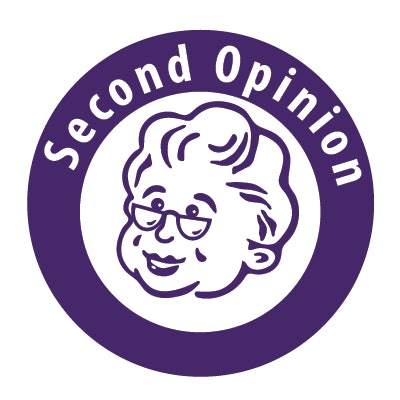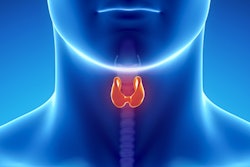
In an article published July 21 in BMJ, researchers from the University of Michigan Comprehensive Cancer Center questioned whether the use of imaging after treatment for thyroid cancer improved patient outcomes.
Banerjee et al reported on statistical analysis of data spanning the years 1998 to 2011 that included more than 28,000 patients who had information available in the Surveillance, Epidemiology, and End Results (SEER) and Medicare databases.1
 Dr. Mark Tulchinsky of Penn State University.
Dr. Mark Tulchinsky of Penn State University.The authors evaluated the rate of utilization of neck ultrasound (NUS), PET, and radioactive iodine whole-body scan (RAI WBS) in the surveillance (i.e., after initial treatment) of patients with differentiated thyroid cancer (DTC).
Their conclusion is rather disappointing for any physician practicing diagnostic imaging, as they state: "Imaging after primary treatment could lead to more treatment for recurrence; however, without an improvement in survival, except for radioiodine scans in presumably iodine-avid disease, it is not clear whether more imaging equals better care."
This conclusion clearly downplays the only test found to be positively associated with improved survival -- the radioactive iodine whole-body scan. It is unusual, if not unheard of, that a test showing positive association with survival is not the main focus of the article. But what this de-emphasis reveals is the researchers' conviction that all imaging is overused in surveillance of differentiated thyroid cancer.
The most important finding
The authors' objective was to "determine whether the use of imaging tests after primary treatment of differentiated thyroid cancer [i.e., surveillance imaging] is associated with more treatment for recurrence and fewer deaths from the disease."
Let us start with what should be the most important finding: association of radioactive iodine whole-body scan with improved survival. In the cohort of 28,220 patients, 6,753 (23.9% of the total) had at least one surveillance RAI WBS, followed by treatment in 3,247 (48.1% of scanned and 11.5% of total cohort). Of these 3,247 recurrences, 358 (11%) patients died from thyroid cancer.
There were 21,467 (76.1%) patients who did not undergo RAI WBS, but 3,255 ended up receiving treatment for recurrence. This is a clinically baffling finding for some of us in nuclear medicine and nuclear radiology.
Why would one treat for thyroid cancer recurrence without finding out if the cancer is iodine-avid and thus suited for RAI WBS? This is the most opportune circumstance to define the most critical characteristic of DTC. With haste to operate on the recurrence without RAI WBS, one would miss the following opportunities:
- To find out if the cancer is iodine-avid or not (usually unknown or uncertain after the initial treatment)
- If the recurrence is iodine-avid, to determine the presence of additional metastatic lesions
It is fairly common that recurrence is suspected on neck ultrasound and confirmed by fine-needle aspiration biopsy. The most common impulse for a treating endocrinologist is to have it removed surgically. It is wise to take the time to perform RAI WBS with SPECT/CT first to determine iodine avidity and stage the disease fully. Informed by the RAI WBS findings, one can make much better treatment decisions.
However, as this report shows, it is common practice to skip this opportunity to determine the tumor's iodine avidity and the extent of its metastatic spread. One could try explaining this by pointing out that DTC could be noniodine-avid, and that is why about 76.1% of all patients and 52% of recurrences did not get the RAI WBS, or they failed the first RAI treatment and are considered to be RAI-resistant.
Prior observations show that only about one-third of all patients with differentiated thyroid cancer are noniodine-avid.2 Thus, it is likely that some patients who were iodine-avid did not get the benefit of RAI WBS and the RAI treatment.
Were deaths preventable?
In this group of 3,255 recurrences who were not imaged with RAI WBS, 797 (24.5%) died of DTC. This raises the question of whether death could have been prevented in a significant percentage of the 797 DTC patients who did not receive the benefit of RAI WBS, with consequent loss of RAI treatment opportunity.
A reader may be baffled by the authors' disregard of the obvious underuse of the RAI WBS and the resulting missed opportunity to reduce mortality in DTC. The reason for overlooking one of the largest elephants that has ever wandered into the middle of a research laboratory is easy to understand by recognizing the investigators' overarching bias -- the overuse of surveillance imaging.
The authors concede that one of the study limitations is a lack of information on "patient-specific data such as iodine avidity, patient preference, and indications for imaging or procedures" (emphasis added). But there are significant differences between PET, neck ultrasound, and RAI WBS with respect to the lack of indication information.
The RAI WBS could have only one indication in this population -- assessment for DTC recurrence. Hence, lack of indication records is not a limitation. The neck ultrasound is almost exclusively performed for DTC surveillance in patients after thyroidectomy, and lack of specific indication is almost a moot point.
PET (likely PET/CT in the overwhelming percentage of cases), on the other hand, could have had many different indications in this cohort of mostly older patients, such as evaluation of other concurrent cancers or a pulmonary nodule (all use the same procedure codes). The test is also indicated in patients with seizures and dementia, which involves imaging only the head, coded with current procedural terminology (CPT) codes 78810 and 78814. The authors specified in the methods that these codes were included in collecting the data, but they are not ever applicable to DTC surveillance.
Therefore, if an elderly patient in this study had clinical signs of dementia for which PET was done, the authors would have counted it erroneously as another test for DTC surveillance. Given the older age of the study cohort, it is likely that a considerable percentage of PET exams were done for non-DTC indications.
It has been shown in the Medicare population that PET utilization for only the six most common cancers increased at a mean annual rate of 36% to 54% between 1999 and 2006.3 Therefore, PET data were likely significantly compromised by the lack of the indication.
This problem represents the second elephant in the room. It would be most reasonable to conclude that this proverbial elephant crushed the validity of PET data, making results uninterpretable. The invalid claim that PET is not useful (i.e., not associated with survival advantage) in thyroid cancer patients could influence third-party payors in prompting coverage denial, causing heightened anxiety and possibly harm to those who require scans for recurrence management. The payors would have financial incentive to overlook this proverbial elephant in the manuscript, but hopefully this editorial will shine the light on the obvious.
The BMJ authors display annual utilization numbers for all three imaging tests combined, plotting this cumulative rate against the years (1998-2011) in figure 1 of the paper, and it shows a steeply rising utilization of these tests. However, the same research group previously published a report where each test was plotted separately.4 The test done most frequently by a significant margin was neck ultrasound, and it showed a steep growth rate.4
In the July 21 paper, neck ultrasound was performed in 56.7% of all patients (this is more than RAI WBS and the inflated PET numbers combined), and 75.6% of those patients had a subsequent procedure or treatment. However, there was no positive survival benefit found with neck ultrasound utilization.1
Yet the authors do not advocate specifically for curbing neck ultrasound, but instead try to explain why the test does not show a survival benefit. The overused NUS is the one and only test in this paper that lacked utility by the authors' definitions, and the only test the authors had reason to call for "curbing."
Instead, the authors offer readers a nebulous truism -- the "findings emphasize the importance of curbing unnecessary imaging" -- which is the third proverbial elephant in this paper. Endocrinologists practicing in the U.S. are known to perform and bill for neck ultrasound performed on their own patients.5 Protecting the interests of the specialty colleagues could be the bias that caused the authors to heavily camouflage this elephant by conflating the other two tests.
Our investigation triggered obvious questions that were submitted to the authors for consideration on BMJ's electronic bulletin board, called the "rapid response."6 The above comments were also posted for the authors to debate, but they chose to gloss over all of that in their reply by offering readers a lineup of idealistic truisms and generalities.
They did not acknowledge the methodological error pointed out above -- instead offering opinions that mostly inflated the significance of their own investigation.7 Such an approach may be acceptable in politics, but it is not appropriate when it comes to the science intended to safeguard the well-being of our patients.
References
- Banerjee M, Wiebel JL, Guo C, et al. Use of imaging tests after primary treatment of thyroid cancer in the United States: population-based retrospective cohort study evaluating death and recurrence. BMJ. 2016;354:i3839.
- Min JJ, Chung JK, Lee Y, et al. Relationship between expression of the sodium/iodide symporter and I-131 uptake in recurrent lesions of differentiated thyroid carcinoma. Eur J Nucl Med. 2001;28(5):639-645.
- Dinan MA, Curtis LH, Hammill BG, et al. Changes in the use and costs of diagnostic imaging among Medicare beneficiaries with cancer, 1999-2006. JAMA. 2010;303(16):1625-1631.
- Wiebel JL, Banerjee M, Muenz DG, et al. Trends in imaging after diagnosis of thyroid cancer. Cancer. 2015;121(9):1387-1394.
- Endocrine Certification in Neck Ultrasound (ECNU) Program page. American Association of Clinical Endocrinologists website. https://www.aace.com/ecnu. Accessed August 19, 2016.
- Avram AM. Re: Use of imaging tests after primary treatment of thyroid cancer in the United States: population-based retrospective cohort study evaluating death and recurrence. BMJ. http://www.bmj.com/content/354/bmj.i3839/rr-0. Accessed September 20, 2016.
- Haymart MR. Re: Use of imaging tests after primary treatment of thyroid cancer in the United States: population-based retrospective cohort study evaluating death and recurrence. BMJ. http://www.bmj.com/content/354/bmj.i3839/rr. Accessed September 20, 2016.
Dr. Mark Tulchinsky is a professor of radiology and medicine and associate director of nuclear medicine at Penn State Milton S. Hershey Medical Center.
The comments and observations expressed herein are those of the author and do not necessarily reflect the opinions of AuntMinnie.com.




















